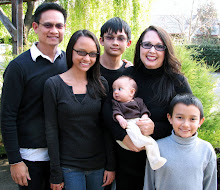
The sixth graders at Davis Waldorf School completed their three week block of physics where we covered the phenomena of sound, light, and magnetism. In the sixth grade, physics is about the experience and observation of the phenomena. There is less emphasis on quantitative data, and more on the quality, the sense-experience, of light, sound, and magnetism. However, I found myself not sticking strictly with the experience, but diving into the abstract as well. Maybe it is my science background, or perhaps the way the students had appeared to want to know about the abstract stuff such as sound waves, but I found myself introducing the hidden mysteries of the experience, in particular, the idea of the wave. I had to use my intuition as a teacher.
For light, I organized the material and the main lesson pages as:
1) the phenomenon of light, where I had the students copy the "gift of light" verse we sang at our Winter Assembly,
2) the sources of light, where we drew images of luminous objects, those that actually produce light, and illuminated object, everything else that reflects light,
3) the rays and rainbows of light, where we identified the properties of the light ray as reflecting, absorbing, and transmitting, including using a prism to see how visible light separates into the rainbow colors, and
4) the refraction of light, where we performed an experiment. We shone a beam of light through a water-filled tank at an angle, and observed the bending of the light as it passed from the medium of air and into the medium of water.
For sound, I organized the main lesson this way:
1) phenomenon of sound, where the students copied a verse about hearing,
2) making sound, about the three ways that sound is produced: striking, strumming, or blowing, told as a story about a king wanting music played at a spring festival,
3) affecting sound, about the qualities of sound: duration, volume, pitch, and character,
4) hearing sound, where we discussed the vibration, and the sound wave, and its properties such as frequency and amplitude. I wrote a rap about sound:
vibrations, vibrations
objects in motion
strum, pluck, or blow,
and feel the sound waves go
sound can be high
sound can be low
sound can be really loud
or quiet like an echo, echo, echo
sound goes on and on and on
sound can stop like this
sound has character
a bark, meow, or hiss
frequency and amplitude
waves have attitude
patterned or continuous
waves are not superfluous
big words - don't you fear
c'mon, just use your ears!
For magnetism:
1) the phenomenon of magnetism, where in our main lesson page, I had them copy down a medieval style of courtly love poem (force of attraction = magnetism, get it?)
2) earth's magnetism, about the history of the discovery of lodestone and its use in navigation
3) field of magnetism, where the students practiced their 3-dimensional drawing and shading to show a magnet and its lines of magnetism.
Our project for the block was making an instrument. The students created some lovely-sounding instruments!
I chose to do a chalk-drawing of a lotus flower in a still pond. The photograph that inspired it had a luminous lotus flower and I wanted to try to capture it in chalk. Also, I was struck by the quietness that the image had. So sound and light.




1 comment:
so fantastic. i wish I would have had you as a teacher growing up- I think my grasp on science and many other things would have been so incredibly different!
Post a Comment